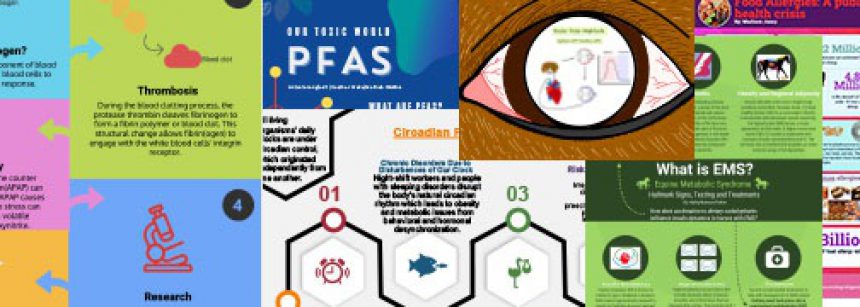Education doesn't stop when the academic calendar closes. At the MSU College of Veterinary Medicine, learning continues yearlong in the form of summer research programs, in which students from many disciplinary backgrounds delve into the world of biomedical research, often for the first time.

The summer research programs, which serve professional and undergraduate students alike, give students hands-on research experience, which prepares them for potential graduate school, or—for the undergraduate students—for professional school.
One goal of the programs is to show students how to bridge the gap between the research they conduct in the lab and the day-to-day understanding of the people they meet in the street. When biomedical research has enormous and amazing implications for human and animal health, how do you make the public understand—and feel invested?
What Summer Research Programs Exist at the MSU College of Veterinary Medicine?

The College offers mentored summer research opportunities for DVM students. These programs are funded by grants that are provided by the National Institutes of Health (NIH), industry leaders, endowed funds from alumni and donors, and College and University resources.
In addition, the College hosts the Biomedical Research for University Students in Health Sciences (BRUSH) Program for undergraduate and veterinary students. The BRUSH Program serves students from populations underrepresented in biomedical research and is funded by NIH's National Heart, Lung, and Blood Institute and MSU.
Learn more about BRUSH in Advocates and Ambassadors: BRUSH Program Looks Ahead to Shifting Norms, Expanding Knowledge
To that end, student researchers created multimedia presentations to put their research in simple terms. Some adapted to social media with shareable infographics. Others connected science and art by creating poetry and drawings. Others created posters, short written texts, and simple videos that anyone can digest, scientist or not.
One infographic by undergraduate researcher Jackson Tucker, Fibrinogen: Driver of Wound Repair, explains Tucker's research into understanding how the primary driver of blood clots may one day allow researchers to find a new way to heal liver damage, all using colorful blocks and simple icons to deliver information efficiently.
DVM Class of 2023 student Alondra Gallego wrote and recited a poem about her research on uses for losartan, a drug that addresses hypertension. Jessica Hynes, also of the DVM Class of 2023, narrates and illustrates issues behind osteoarthritis in a snappy video that would be at home on TikTok or another social media platform.
Student Projects
Students involved in the College’s summer research programs created presentations designed to communicate their research to members of the public. Here is the student work from 2021:
- Alexandra Chiusano - Acetaminophen Toxicity: Discovering New Ways to Treat the Most Common Cause of Acute Liver Injury
- Alondra Gallego - Losartan Clinical Trial: A Poem
- Amber Hickey - Cystic Fibrosis Lung Microbiome
- Andrew Decker - Relationship Between Piezo1 and Hypertension
- Antonia Langfeldt - Our Toxic World: PFAS
- Arpita Nayak - Enhancing Mucosal Immunity in Neonatal Calves
- Brendan Nagler - Genetics of Copper-Associated Hepatitis in Labrador Retrievers
- Brooke Kahn - Metabolites of Clopidogrel
- Carmen-Maria Garcia - Mechanisms and Effects of Early Life Stress in Pigs
- Champa Danappanavcar - Effects of Wheat Varieties on Healthspan and Lifespan of C. Elegans
- Cory Howard- The ABCDs of Canine Lymphoma
- Ebube Okpechukwu - Chemerin: What Can We Learn?
- Elizabeth Jackson - Safety and Efficacy of Low-Dose Radiation Therapy as a Modality for the Management of Feline Chronic Rhinitis
- Elliot Majlessi - Antibiotic Resistance: A Global Public Health Crisis
- Emily Winn - Circadian Rhythms: Timing is Everything
- Eric Spilker - Is CHOP Protocol Chemotherapy A Possible Cause of CIGD in Canine Lymphoma Patients?
- Hailey Maresca-Fichter - What is Equine Metabolic Syndrome? Hallmark Signs, Testing, and Treatments
- Hailey Penticoff - Understanding Alpha-synuclein Aggregation Propensity in Exotic, Wildlife, and Zoo Animals
- Hannah Hipkiss - Detection of Circulating miRNA as a Diagnostic Biomarker of Bovine Tuberculosis in Cattle
- Hunter Ferchaw - Establishing Normal Blood Values for Giraffe Calves
- Hunter Wojtas - Mosquito-borne Diseases in Michigan
- Ireyon Buchanna - Hypertension and Insulin Resistance
- Jackson Tucker - Fibrinogen: Driver of Wound Repair
- Jessica Hynes - Osteoarthritis Explainer
- Jessica Suarez - The Importance of Improving Preclinical Cardiovascular Safety Studies
- Lauren Phillip - Early-life Adversity: What Swine Farmers Should Know
- Madison Janey - Food Allergies: A Public Health Crisis
- Madison Myers - Moo-moos and Munchies: How Cannabinoids Enhance Dairy Cow Health and Wellbeing
- Megan Allen - Canine Athletes: Are There Differences in How They Undergo Anesthesia?
- Megan Crawford - African Painted Dogs Reproductive Diseases
- Nicole Hamlin - Characterization of Mesenchymal Stem Cells
- Olivia Rodts-Palenik - Canine Claucoma Treatment Trials and Tribulations
- Shannon Skalecki - Elephant Endotheliotropic Herpesvirus
- Sierra McClain - Pets and COVID-19
- Sonia Rafique - Isolating Plasmids in Order to Combat Antibiotic Resistance
- Stephanie Acevedo - Making Mice-icles: Keep Your Rodents Warmer in Thermal Comfort
- Tasha Scarlett - Silica-induced Lupus
- Vanessa Raphtis - Ocular Pulse Amplitude Artwork
Learn more about summer research, and find past student projects, here.
